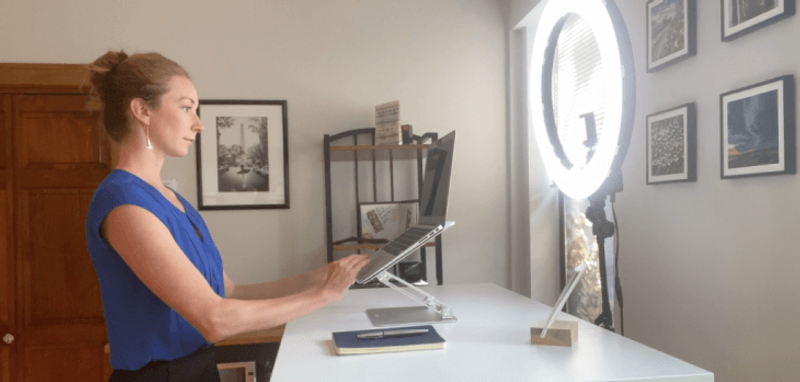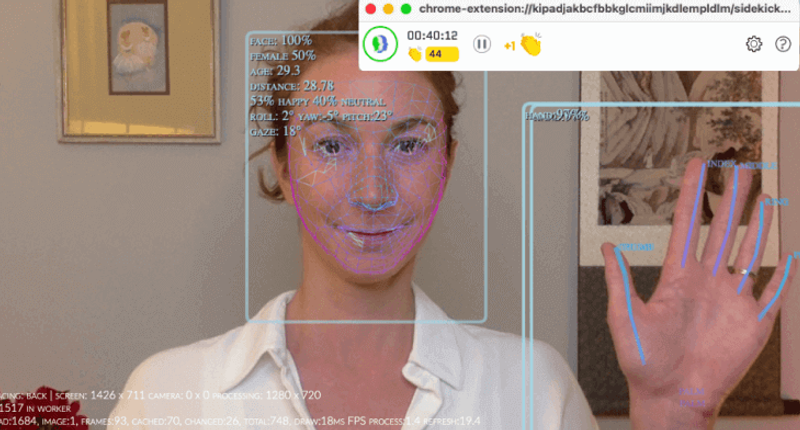Connect with Your Inner Performer: 3 Pre-Event Tips to Feel More Confident Presenting

Maximize Your Marketing ROI
Join 10,000 other marketers already getting the best tips on running engaging events that boost pipeline and create raving fans.
Professional performers (athletes, artists, actors) spend a good deal of time refining their pre-game rituals. Most often, the primary goal of these rituals is to bring mind and body together so that they can perform at their best, on-demand.
In the corporate world, we, the professionals, are the athletes. Whether we are connecting virtually or in-person, presenting to one person or to thousands, many of the elements experienced by a musician walking onto a stage or an actor looking into a camera lens are relevant.
So, what are your pre-game rituals for virtual presentations? What practices do you rely on to help get you into the right state of being to truly perform at your best?
Take a look at my top three tips adapted from the world of professional performance and tailored to suit the needs of virtual presenters in the corporate world.
Tip #1. Close Out Other Projects ❌
On average, people have between 10-20 tabs open at any given time. And this doesn’t even include active desktop applications… Sound familiar?
In a world of virtual presentations, we don’t have the benefit of separating ourselves from projects we may have been immersed in and walking into a different office, conference room, or onto a stage. It can feel odd to go from sifting through those tabs one minute to suddenly presenting to a group of real humans on your screen the next.
As obvious as it sounds, it always bears repeating: be sure to close out all projects and digital distractions before presenting. This is a critical part of preparing for what you are about to do next.
Having a clear digital space is just as important as ensuring you have an uncluttered physical environment.
Tip #2. Get Yourself In The Right Physical State 💪🏽
Following this pre-game flow, once you've closed down your projects and any tab-clutter, now’s a perfect time to get anchored in your body. As you’ll see, the body is a very concrete piece of getting into the right mental state.
Here are three quick exercises to physically ground yourself prior to an event:
- Take a step away from your screen. If possible, stand up and turn away from the screen for a moment. Creating actual physical space between you and your screen can help you reset.
- Breathe deeply in and out. Breath plays a leading role in our ability to stay in the present moment. By breathing in and out, we also help calm down our nervous system. If we are beginning to feel nervous, the breath can help us regulate back to a point where we feel energized and alert, not anxious and disconnected.
- Get connected to your body. Begin by planting your feet firmly in the ground. If you have the space, do a few easy shoulder or arm circles. This will immediately bring you into the present moment and increase blood flow in your body.
You can think of these movements as a way to get any tension or kinks out of your muscles. Physical movement can help you relax, particularly if you tend to hold tension in your neck and shoulder area. And it can help you begin your presentation with an open and upright posture.

Finally, ensure you are wearing clothing that reflects the context of the presentation. Remember, professionalism and confidence are often reflected outward from what we wear.
If virtual, this might not mean a full-on suit and tie—and that’s ok! I like to recommend tops that are comfortable and professional, in solid colors. Be sure to wear your outfit before the event to check and see how it looks on-screen and make sure it’s comfortable to move around in.
These practices together make up the concept of ‘Physical Anchoring.’ Adopted from my experience as an elite athlete and professional ballet dancer, physical anchoring is one of the most powerful tools in my pre-game ritual.
Tip #3. Get Yourself In The Right Mental State 🧘🏼
Now that our bodies are activated and have helped us ground in the present moment, we can start to activate our mindset around our intention.
First, bring to mind your intention behind the presentation. Come up with a list of questions that will help get your intention set firmly. For example, you might ask:
- What is my goal with this event, and how do I want the audience to feel as I take them through the presentation?
- Is this a high-energy event?
- Is there a challenging moment where difficult news must be shared?
- If appropriate, how can I engage the audience throughout the presentation?
With your intention in mind, now is the time to embody it. Calling in Dr. Amy Cuddy’s ‘Power Posing’ is often a favorite.
Whether you expand your posture to help reinforce your feelings of confidence and authority, or you again take a few deep breaths, imagine the feelings and emotions that connect with your intention.
Finally, it’s not uncommon to begin to have a physiological stress response as you really get into the mindset of a presentation. For example, you might have butterflies in your stomach, an accelerated heartbeat, dry mouth, or shortness of breath. In moments like this, calling back the breath and the feeling of being sturdy and rooted into the ground can help significantly.
—
A few final notes…
Our bodies are always in the present moment. The issue is we are often disconnected from our bodies, so we can’t leverage their full power.
Ensure you give yourself enough time to really move through your own specific ritual. Bake into this time a moment to get yourself situated in your virtual space.
Tools like Virtual Sapiens Sidekick can help with this in a fun and effective way so that when you join the meeting, you are providing your audience with a strong impression of confidence, authority, and authenticity.

In practicing some (or all) of the above techniques, you will find you get into a pre-presentation flow. You can get very efficient with this practice and really start to trust it.
Give yourself the time and space to develop a ritual that will support you in your virtual environment. Refer back to this article as often as you need and remember, we build skills over time and with practice. The more presentations you do, the easier this will become in time!

Transform Your Video Marketing with AI
Stay In Touch
Platform
Resources
© 2025 Copyright Goldcast, Inc. All rights reserved.





 Upcoming Events
Upcoming Events Event Series
Event Series On-Demand Events
On-Demand Events

